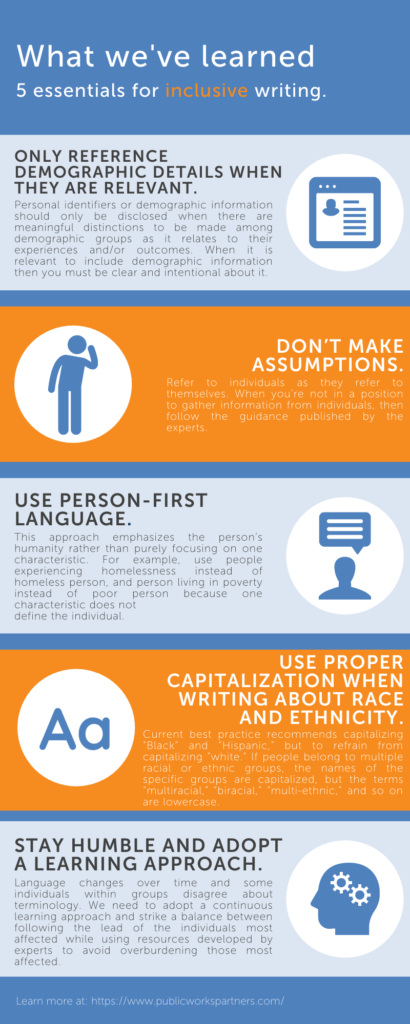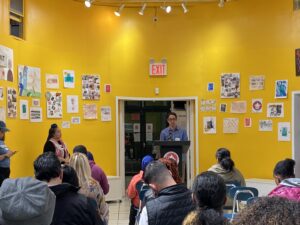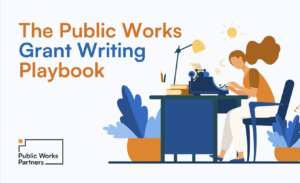There is a collective imperative to directly address issues of racial equity and inclusion in our country, cities, communities, and workplaces. Equity and inclusion have been implicit values of Public Works Partners since its founding. However, to meet this moment, we realize that we need to be explicit about our values. For this reason we are asking ourselves “what can we do to create an inclusive workplace?”
Inclusion is “the action or state of including or being included within a group or structure … [Unlike diversity,] inclusion involves an authentic and empowered participation and a true sense of belonging.”[1] Inclusion can be a step toward equity, which is “about each of us getting what we need to survive or succeed—access to opportunity, networks, resources, and supports—based on where we are and where we want to go.”[2]
In our pursuit to answer this question and implement inclusive practices, we are putting the full energy of our firm to establish a work culture that acknowledges, values, and respects differences among our staff, clients, and the people impacted by our work. Last month we published a blog post that described our internal audit of staff resources including project tools, guidance documents, and specific how-to manuals, to ensure that resources provided to new and current staff explicitly state our values as a firm and prioritize inclusion across all elements of our work. All staff are involved in the review process to keep us accountable to each other, to encourage discussions that check our individual biases, and to ensure that each staff member’s unique experience and perspective are reflected in our internal tools.
We are examining our firm’s internal guides and resources, because how they are written communicates our values. Our internal resources provide guidance to staff about how to work together and how to approach external work with clients. The words we say, write, and read inform our actions and they have the power to create safe and empowering spaces for our employees, partners, clients, and the people who are impacted by our work. We must look inward and set an explicit tone and direction for our firm when it comes to how we approach matters of equity and inclusion.
Why this is important to us
Public Works Partners is a mission-driven firm. We help government and nonprofit clients to increase their impact, and we lead public engagement efforts to ensure that community feedback informs proposed neighborhood projects. There is an implicit understanding among our staff that our firm prioritizes equity and inclusion by the very nature of our work, but we see this moment as an opportunity to explicitly delineate our values as a firm and establish a workplace culture that discusses equity and inclusion openly and regularly during both internal staff meetings and meetings with our clients. From day one, we want our staff to feel valued for their ideas and perspectives, and to always feel empowered to raise questions or issues around equity and inclusion as part of our work.
Building a firm culture that encourages discussions about equity and inclusion is paramount to our success because it helps our staff to feel valued and seen, empowered to hold conversations with clients who grapple with these pervasive and important topics, and encouraged to continue learning from each other, our clients, our partners, and the people most impacted by our work.
What we’re learning
We are learning a lot about inclusive language as we update our firm’s resources, specifically our Writing Guidelines. After reviewing multiple existing resources developed by the American Psychological Association (APA)[3], Human Rights Campaign[4], the National Disability Authority[5], the Associated Press (AP), and other experts, we are sharing the takeaways that stood out most regarding how to write and talk about race, ethnicity, disability, gender identity, sexual orientation, and other significant personal identifiers. We link you to resources so that you can dive into the details further.
 Reference demographic details only when relevant. Disclosing personal identifiers or demographic information is not always pertinent. It should only be done when there are meaningful distinctions among demographic groups as it relates to their experiences and/or outcomes. When it is relevant to include demographic information, then you must be clear and intentional. For example, ask yourself if disclosing someone’s gender identity is integral to understanding the scenario or the person’s experience. If the answer is no, then we do not need to include that detail about the person. In some cases, it may be harmful to include demographic information because it could influence how a reader interprets the individual’s experience compared to what the reader considers to be the norm. The reader may discount an experience based on the demographic information. The APA offers specific guidance on this topic here.
Reference demographic details only when relevant. Disclosing personal identifiers or demographic information is not always pertinent. It should only be done when there are meaningful distinctions among demographic groups as it relates to their experiences and/or outcomes. When it is relevant to include demographic information, then you must be clear and intentional. For example, ask yourself if disclosing someone’s gender identity is integral to understanding the scenario or the person’s experience. If the answer is no, then we do not need to include that detail about the person. In some cases, it may be harmful to include demographic information because it could influence how a reader interprets the individual’s experience compared to what the reader considers to be the norm. The reader may discount an experience based on the demographic information. The APA offers specific guidance on this topic here.- Don’t make assumptions. You don’t need to guess how to describe individuals by their race, ethnicity, disability, sexual orientation, etc. You should refer to individuals as they refer to themselves. When you are not in a position to gather information from individuals, then follow the guidance published by the experts. For example, the Human Rights Campaign published a glossary of terms to help facilitate more conversations around sexual orientation and gender identity and expressions. The New York City Mayor’s Office for People with Disabilities also published an inclusive terminology guide. In our own work supporting the Hudson Yards Hiring Network, a public-private collaboration designed to identify and recruit talent among New York City residents served by local workforce development nonprofits, we followed guidance from the Mayor’s Office for People with Disabilities to ensure all job announcements and weekly newsletters met language and formatting standards.
- Use person-first language. This approach emphasizes the person’s humanity rather than purely focusing on one characteristic. For example, use people experiencing homelessness instead of homeless person,[6] and person living in poverty instead of poor person, because one characteristic should not define the individual. As a firm, we are actively exploring how to incorporate person-first language into our projects. It can be challenging as terms evolve, there are varying opinions on what is appropriate, and longstanding and widely used terms like “low-wage worker” do not follow person-first language. The APA provides guidance on this topic, which is even more nuanced when it comes to describing a person’s disability, race, and ethnicity.
- Use proper nouns and capitalization when writing about race and ethnicity. There is a current understanding that “Black” should be capitalized when describing a person’s race, ethnicity, or cultural background, along with Hispanic, Asian, Native American, Native Hawaiian and Pacific Islander, and other races and ethnicities. However, there is an ongoing debate as to whether “white” should be capitalized. Capitalizing white may reinforce privilege, but not capitalizing the word may reinforce “white” as the norm/default.[7] When people belong to multiple racial or ethnic groups, the names of the specific groups are capitalized, but the terms “multiracial,” “biracial,” “multi-ethnic,” and so on are lowercase. When writing about people who identify as Hispanic, Latinx (Latino is masculine and Latina is feminine, Latinx is non-binary/gender neutral), Chicano, or another related designation, you should consult with individuals to determine their preferred descriptor. Access the APA’s guidance on how to write about race and ethnicity here.
- Stay humble and adopt a learning approach. Language evolves and some individuals within groups disagree about terminology. This can discourage folks from participating in discussions about identity because we don’t want to “get it wrong” or offend someone. If we avoid difficult conversations, then we are not helping to build an inclusive environment. Adopt a continuous learning approach and strike a balance between following the lead of the individuals most affected while using resources developed by experts to avoid overburdening those most affected.
We want to hear from you
Collaborative efforts to create more inclusive workplaces are never finished. There is always more for us to learn from each other and room for improvement. We would love to hear from you about the actions you are taking to create inclusive workplaces. Post an example on Twitter and Instagram with the hashtag #strategyforgood and tag @PublicWorksIQ so we can learn from you and continue sharing promising practices with our broader community.
[author] [author_image timthumb=’on’]https://www.publicworkspartners.com/wp-content/uploads/2019/02/AureliaAceves-2019.jpg[/author_image] [author_info]As Senior Manager at Public Works Partners, Aurelia designs and implements formative evaluation studies to strengthen the organizational capacity of nonprofit organizations to meet the needs of their program participants. She brings experience working on issues related to community development, economic and workforce development, post-secondary education, the delivery of human services, health and public safety, and community partnerships.[/author_info] [/author]
[author] [author_image timthumb=’on’]https://www.publicworkspartners.com/wp-content/uploads/2019/02/CelesteFrye-2019.jpg[/author_image] [author_info]Celeste is Principal & CEO of Public Works Partners. She is passionate about helping mission-driven organizations increase their positive impact on local communities through programs grounded in data analysis and management practices. Celeste provides strategic insight and leadership for every client project, facilitates high-stakes conversations and workshops, and sets the vision and values for the practice.[/author_info] [/author]
[1] https://www.aecf.org/resources/race-equity-and-inclusion-action-guide/
[2] https://ssir.org/articles/entry/what_the_heck_does_equity_mean#
[3] https://apastyle.apa.org/style-grammar-guidelines/bias-free-language
[4] https://www.hrc.org/resources/glossary-of-terms
[5] http://nda.ie/Publications/Attitudes/Appropriate-Terms-to-Use-about-Disability/
[6] https://www.usich.gov/news/people-experience-homelessness-they-arent-defined-by-it/
[7] https://apnews.com/7e36c00c5af0436abc09e051261fff1f





 Public Works Partners is a WBE/DBE-certified urban planning and consulting firm. Our expertise lies in creating innovative, equitable, and sustainable solutions to complex problems.
Public Works Partners is a WBE/DBE-certified urban planning and consulting firm. Our expertise lies in creating innovative, equitable, and sustainable solutions to complex problems.